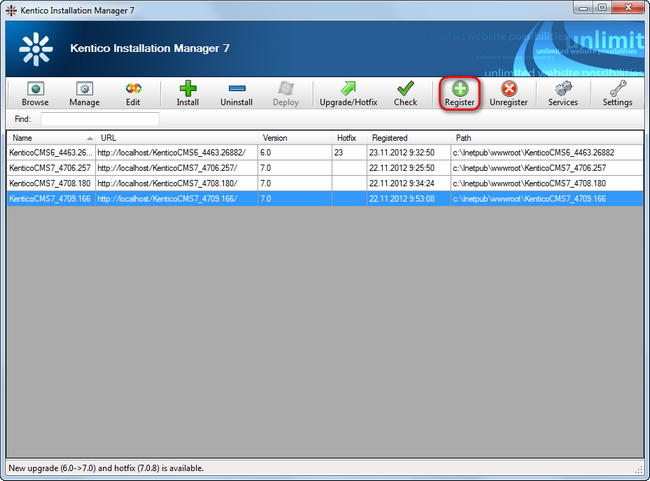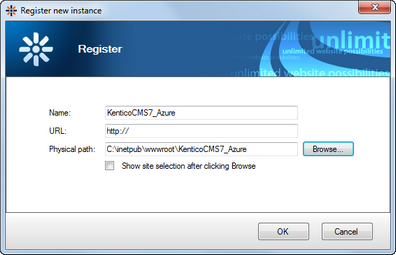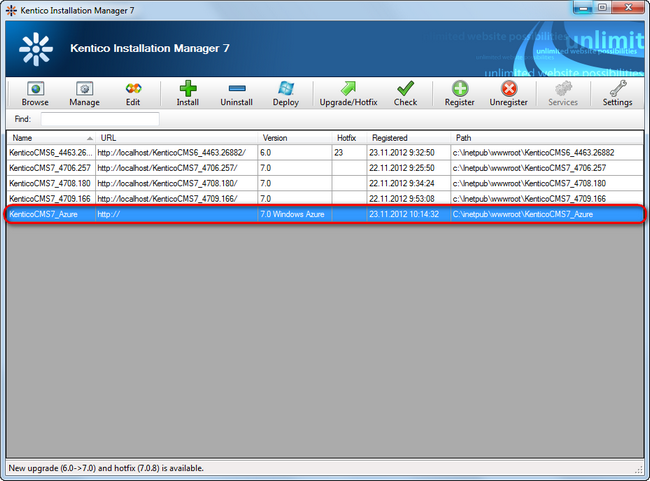Instance registration |

|

|

|

|
|
Instance registration |

|

|

|

|
|
|
||
Kentico Installation Manager is able to register installed Kentico CMS instances automatically. In some cases though, the registration process may not complete successfully and you will have to register the instances manually. Such cases can include:
•You have Kentico CMS instances of versions prior to 6.0 already installed on your machine.
•You installed a Windows Azure project.
1.Click ![]() Register on the main toolbar.
Register on the main toolbar.

Registering a new KenticoCMS instance
A new dialog box appears.
2.Enter the following details:
•Name: identifying name of the instance displayed in the Name column in the list of instances.
•URL: URL under which the instance is accessible.
•Physical path: path to the instance's web project root folder in the file system.
•Show site selection after clicking Browse: if enabled, the tool displays a dialog box with available web sites of the particular instance after clicking the ![]() Browse button (useful for multi-site instances).
Browse button (useful for multi-site instances).

The details of the instance to be registered
3.Click OK.
The KIM registers your instance and displays it in the list of managed instances.

The tool adds the newly registered instance to the list
Information about registered instances is stored in c:\ProgramData\KIM\kim.xml. Within the root <sites> element, it contains a number of <item> elements which represent particular registered instances. The <item> elements have the following sub-elements representing properties of the registered instances:
•<guid> - unique identifier of the instance. Its value is taken from the CMSApplicationGuid key in the appSettings section of the instance's web.config file.
•<url> - URL under which the instance is accessible.
•<name> - identifying name of the instance displayed in the Name column in the list of instances.
•<version> - version of Kentico CMS.
•<path> - path to the instance's web project root folder in the file system.
•<created> - date and time when the instance was registered in Kentico Installation Manager.
•<hotfix> - number of the latest hotfix applied to the instance.
•<netversion> - version of .NET Framework used by the instance. The number of .NET version does not correspond to the number stored here, they are encoded in the following way:
.NET version |
Encoding number |
2 |
2 |
3.5 |
4 |
4 |
8 |
4.5 |
16 |
•<showlist> - indicates if a dialog box with available web sites of the particular instance is displayed after clicking the ![]() Browse button.
Browse button.
Here is a sample extract from the xml file:
<?xml version="1.0"?> <sites> <item> <guid>7d6b7a6e-5f3a-4403-97d0-970dcabba91d</guid> <url>http://localhost/KenticoCMS7</url> <name>Kentico CMS 7</name> <version>7.0</version> <path>c:\inetpub\wwwroot\KenticoCMS7</path> <created>2012-10-30T11:52:59</created> <hotfix>0</hotfix> <netversion>8</netversion> <showlist>1</showlist> </item> ... </sites> |